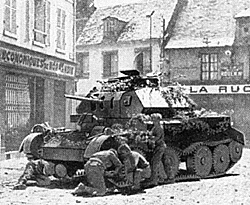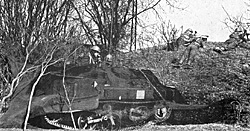Fortress Movement Bonus
Allied units in fortresses may move freely from one fortress square to another, even along the entire fortress line from hex 412 to hex 123. They may elect instead to add a 4-square bonus movement to their movement allowance, in which case the bonus must be taken in an unbroken fortress chain. If an Allied unit elects to use the first option of unlimited movement through an unbroken fortress chain, the unit must begin and end in a fortress; and in any case to receive a fortress movement bonus the unit must start in a fortress.
Allied units in fortresses may move up to four squares within a fortress chain at the end of the movement phase of the German player's move, and before the German player announces any attacks. Any number of Allied units within the fortress system may make such moves, and they may change places if desired. They may not cross any breaks in the fortress line or move outside fortresses for this movement.
Combat with Fortress Units
Allied units in fortresses are neuer required to counterattack. Attacks on fortresses are very complex, as follows: a result of BR means both retreat, and the attack cannot be renewed. A result of CA results in German loss of a unit which took part in the combat, and the retreat of one allied unit from the fortress; this unit must retreat outside all fortresses. The German player may now continue his attack at whatever new odds result against the fortress square. HE MAY use units adjacent to the fortress which, because of stacking rules, could not previously participate in the attack. (For example, if he had had two corps of infantry in a stack; only one could participate in the original attack; that corps was lost; the other may now attack in the renewal.)

A British tank crew replaces the broken tread on their Cruiser tank in the retreat to Cherbourg for evacuation in June, 1940.
In this renewed attack, a result of CA eliminates another attacking German unit if and only if an Allied unit remained in the fortress; that is, if the Allies had two or more units in the fortress and one was forced to retreat by the "CA" result, the other would have remained. A second "CA" means another German unit is destroyed, and another aUied unit must retreat from the fortress. The German may again continue the attack at whatever new odds are now indicated.
In any roll in which the Germans obtain "1CA" or "2CA," ALL Allied units must retreat from the fortress hex under attack, and the German may renew his attack at whatever new odds are indicated. The German player does NOT lose a unit if he roUs "1CA"or "2CA".
These attacks continue until the German player obtains "AR", "BR", or has an opportunity to attack the fortress devoid of troops. He gets on1y ONE attack on a fortress devoid of troops, and ignores all results except "BR" (in which case only the German retreats) or "DX". A "DX" destroys the fortress.
A roll of "CA" against an unoccupied fortress square means no result. The attack is not renewed, and the German loses no units.
German players may employ air strikes against fortresses with the usual rules.
Discussion: Attacks against defended fortresses are costly, particularly if pressed home. In a typical attack of 3 German infantry corps supported by an air strike and artillery units, the German player faces 4/9 chances of losing at least one unit, and 2/9 chances of destroying the fortress.
Special Attack Rules for Allied Armor Units
Whenever more than two divisions of Allied armor are involved in an Allied attack, the combat odds are rounded off to the nearest whole number, not automatically downward. Thus, if the odds reduce to 3:2 and at least two divisions of armor are attacking, they become 3:1, not 2:1. This rule does not apply to German attacks, and only applies to those Allied attacks in which more than two divisions of armor (or armored infantry) take part.
Whenever an Allied player attacks (with any combat force) and obtains a result of "CA", he may elect instead to call that result "DR", i.e., Defender Retreats. He may also at his option require the specified counterattack to take place, but see below.
 A Bren carrier of a cavalry regiment camouflaged behind a bank during a divisional exercise in France. Note Bren gunners and Boys anti-tank rifles on top of bank providing cover.
A Bren carrier of a cavalry regiment camouflaged behind a bank during a divisional exercise in France. Note Bren gunners and Boys anti-tank rifles on top of bank providing cover.
Whenever an Allied player obtains a result of "1 CA" or "2 CA", he may elect to call that result "DR". He may also require the specified counter-attack to take place, and if he does so, a result of "1CA" requires the German player to attack at least three Allied armor units (provided that at least three Allied armor units were in the original Allied attack.) A result of "2CA" requires the German player to attack ALL of the Allied armor involved in the attack (provided that the Allied player elects that option). An Allied result of "CA" requires the German to attack at least two Allied armor units, provided again that two such took part in the original Allied attack.
Whenever, as a result of an Allied attack, the German forces are required to retreat, the Allied player may make, in addition to whatever movement of armored forces he is entitled to, a special move of one square by each of two units. ANY Allied unit, whether or not engaged in the attack, may make this move. In any case, if this special move is made, one unit must move into the square vacated by the retreating German player; the other must move into the square vacated by the retreating German player; the other must move into the square vacated by the first Allied unit. (It is permitted simply to move one unit into the vacated square. )
Discussion: these rules are unrealistic in that they give the Allies an advantage not available to the Germans, and there is no "real world" reason for them. However, they add realism to the game. Their effect is to make it much harder to break an Allied defense line by throwing units at it, then squeezing Panzers into the interstices. Although it would seem that these rules give the Allies an overwhelming advantage, they do not. They do greatly delay a German "brute force" attack.
The latter is highly realistic. Every commentator on WW II has noted that the defender's advantage, once the proper tactics were known, was enormous. It took great superiority to break through a properly organized defense system supported by armored reserves. Pushing unsupported armor into a small gap in the defender's lines was safe enough if the defender had no armored force with which to counterattack, but if he did, such tactics were foolhardy.
Special Stacking Rules
BEF units may not be stacked with other Allied units except when this is caused by retreats; and the Allied player must, on his next turn, remove the BEF units from the stack containing French units. Exception: French units may provide a garrison and defense for British Air Support Elements.
German units may make assaults in violation of the normal stacking rules provided they pay penalties as follows: for every square into which more than one corps equivalent attacks from a single square, one German unit must be removed.
Example: the Germans elect to attack fortress square 154 with six infantry corps, 2 each on squares 153,121, and 122. This is allowed, but one German infantry corps (which must have been one of those attacking) is lost. IN NO CASE may more than one corps equivalent PLUS ONE UNIT attack from a single square, and in every case one of the "extra" attacking units is removed from the board. However, the unit is considered a part of the attacking force, and its combat factors used in computing the odds. It is not removed until the engagement is ended. If, as a result of allied counterattacks, the unit which was intended to have been removed under this rule no longer exists, the German player must elect to remove another unit instead.
Discussion: by use of this rule the Germans will be able, at cost, to break through the Maginot Line if the Allies neglect to defend it. It won't do them a lot of good against the Line if there is a strong Allied garrison in it.
British Bomber Command Unit (Optional)
If the British Bomber Command Units are employed, their bases are in Britain, and they must enter the board from the northwest corner square only. After turn 4 the British may elect to base their Bomber units in Pans, in which case the German forces may attack as if there were a Ground Support Unit on square 1024.
Terrain Effects
Armor units lose 2 combat factors per unit when attacking across rivers or into cities. This loss remains through all phases of the combat including "CA" results. It does not apply to armored infantry. The effect is negated by an air strike; provided, that two air strikes will be needed if terrain effect would otherwise have aided the defense. Example: German units are attacking across the river into Liege, a city. An air strike is needed or the attack must subtract two from the die-roll. With one air strike, armored units must still be reduced by 2 factors/unit. A second air-strike negates this advantage.
Where all attacking units must cross a river, and are attacking into a defended forest square, the attacker subtracts two from his die-roll. An air strike does not change this result. Two air-strikes negate the defender's advantage, BUT armor attacking across the river must subtract 1 combat factor per unit from its strength.
The above are the only exceptions to the one air strike per combat rule.
Victory Conditions
The game extends for 12 turns, not 10; that is, until June 2.
The Allies receive 4 Victory Points for each German Armor factor eliminated, and two Victory Points for each German Armored Infantry factor eliminated.
Author
J.E. Pournelle is an author, game designer, and journalist whose recent works include (with Stefan Possony) The Strategy of Technology (Dunellen, 1970 [second edition in preparation] and A Spaceship for the King (DAW Books, 1973). He was a consultant in strategy for the U.S. Air Force (Headquarters, USAF, Office of Doctrines, Concepts and Objectives) from 1964-69, and a principal investigator for Stability in the Modern World, published by the Air Force in 1968 (three volumes; volumes I and II unclassified). Dr. Pournelle is a frequent contributor to American Legion magazine and Analog science fiction magazine.
Back to Conflict Number 5 Table of Contents
Back to Conflict List of Issues
Back to MagWeb Master Magazine List
© Copyright 1998 by Dana Lombardy
This article appears in MagWeb (Magazine Web) on the Internet World Wide Web.
Other military history articles and gaming articles are available at http://www.magweb.com